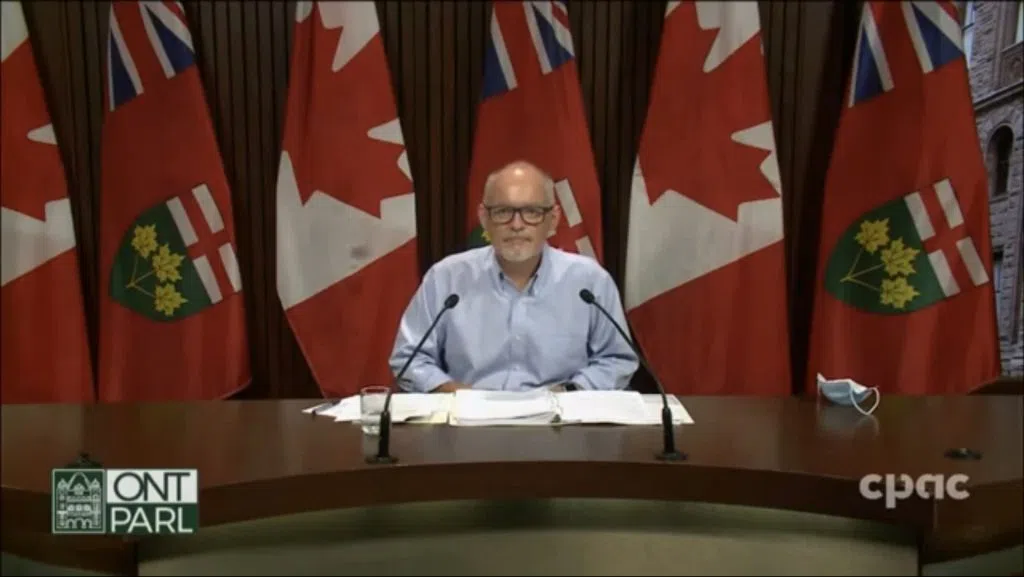In person classrooms will return to Ontario students this September with remote learning continuing to be an option. The province unveiled it’s official back-to-school plan yesterday, but the plan shows few details on how schools will manage COVID-19 outbreaks and cases.
Staff and students, Grade 1 and up, must continue to wear masks in indoor settings, with exceptions such as breaks and low-contact physical activities. Self-screening will still be required before entering any school facility.
Field trips, team sports, and extracurricular activities will come back starting this September, along with recess and assemblies. Students can also be in shared spaces such as cafeterias and libraries.
Here is more information from Ontario’s back-to-school plan:
- Staff and teachers will not be required to take COVID-19 vaccines.
- Self-screening must be completed everyday using the province provided tools, although enhanced screening may be directed in some schools.
- School boards are expected to have all ventilation systems inspected and in good condition before the start of the school year.
- School boards will be required to provide students learning remotely with 300 minutes of learning opportunities.
- Students do not need to stay with their cohort during recess and breaks outside.
- Nutrition/third party food programs and non-instructional food events (such as a pizza day) are permitted to operate.
- Music programs will be allowed in areas with good ventilation (including singing and wind instruments as long as social distancing is maintained in cohorted groups.)
- School boards without mechanical ventilation (those who rely on windows to bring in fresh air) are now expected to place standalone high efficiency particulate air (HEPA) filter units in ALL classrooms.
But the 29-page plan released Tuesday contains no protocols on managing potential COVID-19 outbreaks, as mentioned before, nor is there a set threshold within the document for when classrooms or schools should be shut down.
Ontario’s Chief Medical Officer of Health Dr. Kieran Moore says that “schools are safest where we maintain high rates of community immunity.”
But when asked under what conditions or circumstances schools might be forced to shut down, he replied, “I really don’t see our schools closing.”
For high school students, each school board has been instructed to implement timetables with no more than two courses at a time. This being in order to “preserve the option of reverting to more restrictive measures, if needed.”
Moore emphasized the importance of vaccination rates in order to prevent a possible spike in cases now due to the delta variant. Adding that we should normalize COVID-19 for schools, similar to the annual rise in flu cases we see each season.
As for testing, Moore says the list of symptoms is being scaled down to focus more on COVID-specific ones, an example being loss of taste. And when asked why the province is not tracking students’ individual vaccinations, Moore said that information would be collected if there was an investigation on an outbreak.

Ontario Chief Medical Officer of Health Dr Kieran Moore giving the provinces COVID-19 update – August 3, 2021: (CPAC)
But the Elementary Teachers Federation of Ontario (EFTO) is calling the Ford government’s plan “inadequate and incomplete.”
The union said it wants to see the government lower class sizes in order to ensure physical distancing, mandate masking for all students including those in kindergarten, as well as reverse an $800-million cut to public education for the upcoming school year, to name a few.
Following that, Dr. Doris Grinspun, chief executive officer of the Registered Nurses’ Association of Ontario, calls it a mistake that the province is not making vaccines mandatory for education staff and students over 12.
The nurses group is wanting the province to provide funding to make permanent positions for around 625 public health nurses within Ontario schools.
And while the “gamechanging” rapid tests, titled by Premier Doug Ford, were deployed in other places such as long-term care homes, the back to school plan makes no mention of rapid testing.
Closer to 5,000 Ontario schools had to close due to COVID-19 cases last year, with almost 11,500 students testing positive to the virus.
Check out the province’s full back-to-school plan here.







Comments